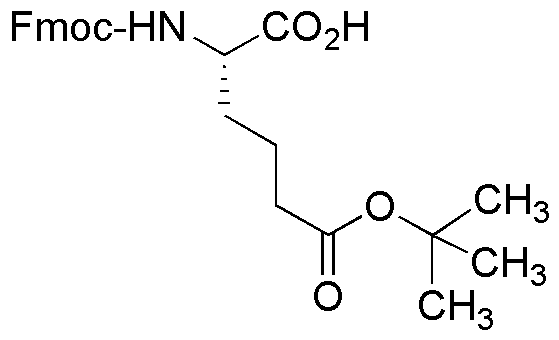|
Fmoc-L-a-aminoadipic acid d-tert-butyl ester is widely utilized in research focused on
- Peptide Synthesis: This compound serves as a key building block in the synthesis of peptides, particularly in solid-phase peptide synthesis (SPPS), allowing for the efficient assembly of complex peptide sequences.
- Drug Development: Its application in drug design helps create peptide-based therapeutics, which are crucial in treating various diseases, including cancer and metabolic disorders.
- Bioconjugation: The chemical is used for bioconjugation processes, enabling the attachment of biomolecules to surfaces or other molecules, which is essential in developing targeted drug delivery systems.
- Research in Biochemistry: It plays a significant role in biochemical research, particularly in studying protein interactions and functions, aiding researchers in understanding cellular processes.
- Modification of Amino Acids: This compound allows for the modification of amino acids, enhancing their properties for specific applications in both research and industrial settings, leading to more effective experimental outcomes.
Informations générales
Propriétés
Sécurité et réglementation
Applications
Fmoc-L-a-aminoadipic acid d-tert-butyl ester is widely utilized in research focused on
- Peptide Synthesis: This compound serves as a key building block in the synthesis of peptides, particularly in solid-phase peptide synthesis (SPPS), allowing for the efficient assembly of complex peptide sequences.
- Drug Development: Its application in drug design helps create peptide-based therapeutics, which are crucial in treating various diseases, including cancer and metabolic disorders.
- Bioconjugation: The chemical is used for bioconjugation processes, enabling the attachment of biomolecules to surfaces or other molecules, which is essential in developing targeted drug delivery systems.
- Research in Biochemistry: It plays a significant role in biochemical research, particularly in studying protein interactions and functions, aiding researchers in understanding cellular processes.
- Modification of Amino Acids: This compound allows for the modification of amino acids, enhancing their properties for specific applications in both research and industrial settings, leading to more effective experimental outcomes.
Documents
Fiches de données de sécurité (FDS)
La FDS fournit des informations de sécurité complètes sur la manipulation, le stockage et l’élimination du produit.
Spécifications du produit (PS)
Le PS fournit une description complète des propriétés du produit, notamment sa composition chimique, son état physique, sa pureté et les exigences de stockage. Il détaille également les plages de qualité acceptables et les applications prévues du produit.
Certificats d'analyse (COA)
Recherchez des certificats d'analyse (COA) en saisissant le numéro de lot du produit. Les numéros de lot et de lot se trouvent sur l'étiquette d'un produit, après les mots « Lot » ou « Lot de fabrication ».
Numéro de catalogue
Numéro de lot/série
Certificats d'origine (COO)
Ce certificat d'exploitation confirme le pays dans lequel le produit a été fabriqué, et détaille également les matériaux et composants utilisés et s'il est issu de sources naturelles, synthétiques ou autres sources spécifiques. Ce certificat peut être requis pour les douanes, le commerce et la conformité réglementaire.
Numéro de catalogue
Numéro de lot/série
Fiches de données de sécurité (FDS)
La FDS fournit des informations de sécurité complètes sur la manipulation, le stockage et l’élimination du produit.
DownloadSpécifications du produit (PS)
Le PS fournit une description complète des propriétés du produit, notamment sa composition chimique, son état physique, sa pureté et les exigences de stockage. Il détaille également les plages de qualité acceptables et les applications prévues du produit.
DownloadCertificats d'analyse (COA)
Recherchez des certificats d'analyse (COA) en saisissant le numéro de lot du produit. Les numéros de lot et de lot se trouvent sur l'étiquette d'un produit, après les mots « Lot » ou « Lot de fabrication ».
Numéro de catalogue
Numéro de lot/série
Certificats d'origine (COO)
Ce certificat d'exploitation confirme le pays dans lequel le produit a été fabriqué, et détaille également les matériaux et composants utilisés et s'il est issu de sources naturelles, synthétiques ou autres sources spécifiques. Ce certificat peut être requis pour les douanes, le commerce et la conformité réglementaire.


